•
HOME
• about
• collection
• books
• index
• links
• lutes
• guitars
early
• guitars
modern
• mandolins
• cittern
• banjos
• steelguitars
• miscellaneous
•
Europe West
• Europe East
• Europe South
• Africa
• Middle East
• Central Asia
• India
• Far East
• S.E. Asia
• America N
• America C
• America S
|
lutes
Lutes belong to the oldest plucked instruments.
Lute-like instruments have been found in archeological remains in the
Middle East and the Far East from as long as 4000 years ago.
In Europe lutes were the most popular instruments for a few hundred
years, especially from 1400 to 1800. This can be seen from the large volume
of books and manuscripts from that period.
The lute (both the instrument and the name) derives from the
Arabian lute, the Ud ("El Ud" -
or Oud), which is still much played (see Middle
East). The instrument probably
reached West Europe from the Middle East via the Moors in Spain, or
was brought home by the Crusadors.
Music for it was always written in tablature - a way of music notation
specially for plucked stringed lute-like instruments, where not the
pitch is notated, but which string on which fret has to be plucked.
Several different systems were in use (Spanish, French, Italian and
the most complicated : German), but all on the same basis : string +
fret.
The lute era ended around 1750, when music (especially
Bach's) became too complicated to be played by non-professionals on
the lute, and was played more easily on keyboard instruments,
like the then popular harpsichord and pianoforte.
The number of strings on a lute slowly increased
from about four courses on early medieval lutes to theorbe
lutes with many extra bass strings, fitted to extra long necks,
reaching finally a total of 14 (double) courses, or 26 strings in total.
Since the Middle Ages there were nearly always double strings in a course.
For some other early medieval instruments, see mandolins
and cittern.
For a good introduction to the history of the lutes see Vanedwards
and Polyhymnion.
|
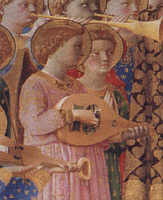 |
early
medieval lute
example : from painting in Louvre, about 1450 |
L=
B= H=mm
scale mm |
| |
|
early
medieval lute
In many old paintings and statues in churches we
can find depictions of the medieval lute. This lute
is quite small and usually has 4 double courses.
Sometimes this early medieval lute is confused with the
gittern (see mandolins),
which has a similar shape. The difference is usually the pegbox
: angled back on a lute, and a sickel-shape with scroll
on a gittern. In fact (more difficult to spot) the lute
body was made from separate ribs, glued together, while the
gittern was carved from one block of wood.
The fingerboard of the lute was made of a strip of separate
wood, and flush with the soundboard. The frets were made of gut,
tied around the neck.
A nice decorated rosette seemed carved into the soundboard. On
some paintings a second rosette can be seen more towards the fingerboard
and some inlay decoration on the front. The strings were tied
to the bridge, which was glued to the soundboard.
This lute could be played with a plectrum
(often a long one, like for the oud), or with the fingers.
The gittern was always played with a plectrum. |
|
| top |
|
 |
medieval lute
example : handmade by Anton Wiegers, NL
(model based on van Zwolle)
bought 1993 |
L=690 B=330 H=170mm
scale 610mm |
| |
|
medieval
lute
There is no surviving medieval lute, but
there exists a scale drawing by Arnout van Zwolle from around
1450.
The body of the medieval lute was usually
quite rounded. It was made of quite thin strips of (sycamore)
wood (the ribs), glued together (on a mould) in a half "ball".
Glueing-on the soundboard gave the body its strength.
The neck was made from a separate piece of wood and glued to the
body. The friction pegs were inserted from both sides to the peghead,
which was fixed at an almost straight angle to the neck. The fingerboard
was flush with the soundboard. In the soundboard a delicate rosette
(with usually an arabian design) was carved for the soundhole.
The gut strings were fixed to the bridge, which
was glued to the soundboard. The medieval lute often
had 5 (or later 6) courses of which the first string was single,
the rest double (with no octaves).
Tuning would be GG cc ff aa d'd' g'.
Quite a lot of music has survived, always written
in tablature.
|
|
| top |
|
 |
vihuela
example : custom made (after the Paris Vihuela) by Paul Doyle,
Ireland 1981 |
L=890 B=240 H=65mm
scale 610mm |
| |
|
vihuela
In 16th century Spain the main plucked instrument
was the vihuela; also called vihuela de mano
or viola a mano (in Italy). Tuned and played like the
lute (which was popular in the rest of Europe), the shape
of the vihuela was like a (slender) guitar.
It is not known why the Spanish prefered this body shape to the
lute, but probably it had to do with the lute reminding
them too much of the oud of the Moors.
It seems that only two vihuelas survived (both now in
Paris' museums), but one is rather large and seems more like a
woodworkers exam piece. A church in Quito (Ecuador) has a guitar-like
instrument, which is also believed to be a vihuela.
The body of the vihuela was made like
a guitar, but with only a few bars under the soundboard
(like the lute). On the existing pictures there are usually
some inlay squares on the front, and a (parchment inlay) rosette
in the soundhole (some had more soundholes). The fingerboard is
flush with the top, and the frets are tied-on gut string. The
friction pegs are inserted from the back of the rather straight
tuning head. The strings are tied to the bridge, which is glued
to the soundboard.
There are about 7 rather large volumes of music
written especially for the vihuela, all from Spain and
from the period around 1550. All are written in tablature - a
kind of music notation, especially for stringed instruments. The
number of courses indicated in the tablature is 4 to 9. This music
is of quite high musical standard, often using multiple voices.
As the tuning of the vihuela is the same as for a normal
renaissance lute, the music of both can be played on
it. For the 4-course renaissance guitar (from the same
period but regarded as a totally different instrument) see under
guitars early.
For much information about these vihuelas,
see Lutesandguitars.
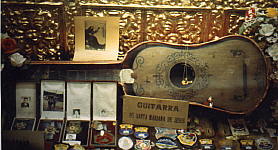 |
Left :
This instrument (that I photographed in 1986) is identified
as a vihuela.
It is in a glass cupboard in a church in Quito (Ecuador),
and looks much like a baroque guitar. |
|
|
| top |
|
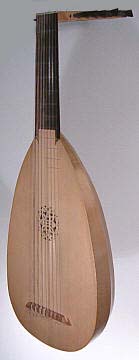 |
renaissance lute
example : custom made by Alan Clark (after Frei lute), UK 1976 |
L=720 B=290 H=160mm
scale 630mm |
| |
|
renaissance
lute
After the Middle Ages the lute slowly changed
from a rounded to an elongated body shape. The number of ribs was from
about 7 to 11. The rosette was always carved in the soundboard.
The fingerboard was made of dark wood (often ebony),
and flush with the soundboard. The friction pegs were placed on both
sides of the open peghead, which was bent back to an almost straight
angle. The frets were pieces of gut string, tied around the neck. The
top frets were of wood and glued on the soundboard. The strings were
tied to the bridge, which was glued on the soundboard.
The number of (gut) strings increased : from 5 to 6,
7, and finally up to 10 double courses.
All strings were on one neck, and could all be fingered, resulting in
a quite wide fingerboard.
The tuning of the top 6 strings was almost like a guitar, but
with an extra, higher tuned string : G c f a d' g' .
The lower (extra) strings (courses) were in fact basses (called "diapasons")
which were only played open, and tuned to the particular piece of music
to play. The top double courses were in unison, but the diapasons were
in octaves. Lutes were made in different sizes to get higher or lower
pitches, to accomodate the singers' voice, and known as for instance
F or G lutes (after the top string), or as "treble" (c or
d), "tenor" (f, g or a) or "bass" lutes (C or D).
There exists an enormous repertoire of lute
music, often found in manuscripts of various players (both professionals
and amateurs) and it is amazing to find that also in those early centuries
some pieces became tophits and travelled quite fast around Europe -
even without the use of modern radio or CD's ! |
| top |
|
 |
orpharion
example : custom made by Alan Clark (after Palmer model), UK 1980
|
L=960 B=270 H=75mm
scale 540/590mm |
|
|
orpharion
The orpharion is a delicate instrument, which seems like
a combination of a cittern and a lute: the tuning
of the lute with the metal ("wire") strings of the
cittern. In fact it is a later version (and about 3/4 size)
of a bandora (see under). Only two original instruments survived
: the Palmer orpharion (in Copenhagen) and the Rose orpharion
(in UK). It was designed in the second half of the 16th century.
The orpharion was made like a guitar,
with a flat or slightly rounded back, and with a beautiful wavy outline
(which fits in the outline of a renaissance lute). The rosette
was carved in the soundboard (like the lute) or made of separate
wood and inserted.
The fingerboard is slightly higher than the soundboard. The back of
the neck is not over the full width, but only on the right (lower) side
: the fingerboard sticks out on the bass side, so forming a kind of
d-shape (a similar neck is found on the cittern). The frets
are pieces of brass, set in the fingerboard. The pegbox is slightly
curved and ends in a curl to the front - either with a square or with
a carved head, like on the cittern.
The strings are made of metal and brass (the basses are twisted), usually
in 6 to 9 double courses. They are fixed to the bridge with hitch-pins.
The most interesting thing of the orpharion is the fact that
the stringlength of the trebles is shorter than that of the basses.
This results in the nut, frets and bridge being placed at an angle,
demanding quite some accuracy from the instrument builder.
The fretboard is a bit scalloped : the wood between the frets is lower
than next to the frets. The frets were usually fixed in the sawcut with
wooden wedges.
The tuning was the same as for the renaisance lute, so often
on music books was written : "For Lute or Orpharion".
The thin metal strings produce a very "singing"
sound, and although every piece for lute can be played on the
orpharion, it is most satisfying to play vihuela music
on it, of which the separate voices stand out much more clearly than
on the short sounding gut/nylon strings.
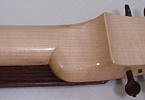 |
Playing on the slanting
frets is less awkward than you would expect. You do have to play
carefully though, to avoid the thin strings cluttering against
the fingerboard.
left :
The d-shaped neck with the fingerboard extending on the bass side. |
|
| top |
|
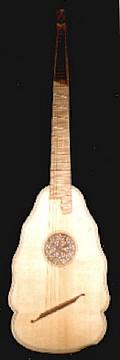 |
bandora
example :
from website Brucebrook |
L= B= H=mm
scale 700-800mm |
|
|
in broken consort |
|
bandora
The bandora (or pandora) is
in fact a slightly bigger version of the orpharion, and probably
designed earlier. It misses the thin top course. The strings were not
gut, but metal (wire and twisted brass), just like on the orpharion.
The bandora was probably designed by John Rose
in England around 1560 and became soon (especially in England) a popular
instrument untill about the second half of the 17th century.
In spite of its popularity, no bandora has survived,
so we have to do with the few surviving pictures. It appears that the
shape of the bandora or orpharion was not really fixed
: anything with some wavy outline seems to have been alright, but most
examples show that the bottom has one large curve, ending on both sides
in a sharp turn.
 |
The bandora
often had only 6 courses of wire strings, and in that case did not
need the slanting arrangement of the frets and bridge, as that was
only necessary for the longer bass length of the 7th course.
Tuning would be (G') C D G c e a (a bit like a guitar).
|
| left : bandora (after the
Rose orpharion) from website Luciano Faria. This model may be a
(historical) hybrid between a bandora and an orpharion. |
The bandora was mainly used to play in the (English)
Broken Consort a kind of "rhythm guitar", together
with the cittern. The other instruments of the Consort were
the lute, the violin, the viola de gamba
and the flute). There is hardly any solo music written for
the bandora.
For some more information about orpharions and
bandoras see lutesandguitars.
For a modern guitar version of slanting frets see : novaxguitars.
|
| |
theorbe
lutes As the
lute became more popular there was a demand to get a better volume
from the basses. Thick gut strings tended to be dull sounding. The first
trick was to use the thickest strings available, but with a higher octave
string in the same course. Next was to increase the scale length. So
you see first the development of stepwise longer bass strings - for
each extra pitch a slightly longer scale.
The next development was to make an extra pegbox and start again with
the less thicker strings up to the thickest. Old lutes were
rebuilt to fit extra strings on additions to the pegbox ("double
headed lutes", and "(bass) riders"), often with much
increased string lengths. All these instruments were in general called
theorbes (or similar in different languages), or arch lutes.
The body often became much bigger
than the original slender renaissance lute, but the tuning
was still the same (for the first 6 fretted strings, plus the unfretted
basses). However, because of the larger body size, the first (single
string) course could not be tuned high enough without breaking, and
so was often tuned an octave lower, as was sometimes even the second
course. This was taken into account for the music (in tablature), although
the theorbes were also often used to play in ensembles the
"basso continue" - a way of playing chords, improvising from
a written short-hand notation : "figured bass".
Finally they found a way to produce
overspun basses, and they could go back to the normal string length
and have all strings together at the end of the neck. |
| top |
|
 |
chitarrone
example : from website Lutesandguitars |
L= B= H= mm
scale ~ 850/ 1600mm |
| |
|
chitarrone
To get really a strong bass sound, the neck of a bass
lute was sometimes extended to about double the stringlength for the
basses.
The first pegbox does not bend back (like on a renaissance lute),
but goes straight up, while the second pegbox (in a complicated way)
bends back to the front. All the bass strings run from a single nut
and could not be played on the fingerboard. Usually the first 7 (unison)
courses could be fretted and were on the lower tuning head. The name
for this long neck lute varies : besides the name chitarrone,
also theorbe or tiorba can be found.
The chitarrone often had extra decoration and
even having 3 rosettes on the very large bodies was common.
It was still in "renaissance tuning", although
the first string was tuned down an octave. On some instruments the gut
strings were replaced by wire strings and sometimes even in single string
courses.
The chitarrone was used in orchestras (e.g.
Mozart) and played "basso continuo" from "figured bass"
(chords) - the lute player had to swing the neck in the rhythm of the
music, to beat the time for the other musicians.
A chitarrone has a stringlength of 760-1000mm
for the petit jeu (fingered strings) and 1550-1700mm for the basses.
A smaller chitarrone would be called an archlute,
with a petit jeu of 640-670mm and 1300 - 1450mm for the basses. |
| top |
|
 |
liuto attiorbato
example : custom made by Alan Clarke (after Sellas lute), UK 1983 |
L=1140 B=330 H=160mm
scale 640/890mm |
| |
|
liuto
attiorbato This type of theorbe
was designed at the end of the 16th century (probably by Piccinini)
and mainly used for solo music written by Italian composers up to the
end of the 17th century. So this particular model is called liuto
attiorbato, after the Italian translation of "theorbe
lute".
In this model of a liuto attiorbato the first pegbox does not
bend back (like a renaissance lute), but goes straight up, while the
second pegbox bends (in a complicated way) back to the front. That pegbox
has a single nut, from which 7 bass courses run, which are passing the
fingerboard too high to be able to be fingered. The first 7 (unison)
courses run from the normal tuning head and can be fingered. The 7 bass
courses are in octaves (sometimes not).
Tuning usually is : F'F G'G A'A B'B Cc Dd Ee / FF GG cc ff aa d'd' g'
This model of theorbe lute was often used by
quite wealthy people and therefore most of the surviving instruments
are highly decorated : with etched ivory plates inlayed in the fingerboard
and sometimes the back of the body was completely made of ivory and/or
ebony.
|
| top |
|
 |
angelique
example :
from book Schlegel |
L= B= H= mm
scale 680 / 1000mm |
| |
|
angelique
The angelique was a theorbe lute (usually
like a French theorbe or with a German swan-neck) with 16 single
strings, and a completely different tuning. It often had 10 fretted
strings and 6 on the bass side.
Tuning would be harplike : D E F G A B / c d e f g a
b c' d' e'
The angelique disappeared rather quickly again.
Being a kind of zither/harp this
angelique should not have been in ATLAS, but is included for
completeness anyway. |
| top |
|
 |
torban
example :
picture from website Stepan Tykhonenko |
L=1270 B= H= mm
scale 0 / 0mm |
| |
|
torban
In Poland and Ukraine the idea of open strings was taken
even further than the angelique. Apparently they used a theorbe
lute (usually like a French theorbe or with a German swan-neck)
and put additional strings on the soundboard, similar to the strings
on their native bandura - the zither instrument which
was very popular in the Ukraine. The torban was used from the
17th century untill the early 19th century.
The torban would be played by plucking the open
strings like on the bandura - the melody plucked on the short
strings and the basses on the long strings on the neck. Apparently the
strings on the neck were sometimes fingered.
Sometimes the name torban was used for the theorbe lute
(so for the fretted version, without additional strings).
The torban has since long disappeared, save
for a few historical reconstructions (see example).
Being a kind of zither/harp the
torban should not have been in ATLAS, but is included here
for completeness anyway.
For more information see Torban.org.
|
| top |
|
 |
german
baroque lute
example : from website Sebastian Nuñez |
L= B= H= mm
scale mm |
| |
|
german baroque
lute or swan
neck lute Another way of extending the bass strings
was by a kind of (sideways) swan neck, usually with some curve in between;
so it is also called the swan neck lute. Like on the liuto
attiorbatto, all the bass strings came from one single nut, and
could not be played on the fingerboard. The total number was usually
13 courses, with 25 strings. This lute was mainly popular in the 18th
Century Germany. It used the baroque tuning.
The baroque lute differed from the renaissance lute
mainly in the tuning : no more a guitar-like tuning, but (after lots
of experimenting, especially in France) an open d-minor on the top 6
courses : AA dd ff aa d'd' f'f'.
The lower basses were tuned in pitches that were depending on the particular
piece of music to be played. The total was usually 11 courses, with
20 strings.
A famous German lute player/composer was Silvius Weiss.
Note that the baroque lutes were used in the
same period as the theorbes : they were different in tuning,
with the theorbes mainly used for "bass continuo". |
| top |
|
 |
french baroque lute
example : handmade by Anton Wiegers, NL bought 1986 |
L=960 B=320 H=170 mm
scale 640mm (-800mm) |
| |
| |
|
french
baroque lute or double
headed lute Eventually at the end of the 17th
century (when they discovered a way to make overspun gut strings) the
normal size lute (without the extra long neck) was also made
with 13 courses. Because the (bend back) peghead would have to be very
long to accomodate so many strings, often an older lute body was used
with the angled-back peghead, but with the tuning-head extented by "riders"
on both sides to accomodate the extra strings, without having to completely
replace the neck. Some riders had small bridges with for each bass string
a slightly longer string length, so the same thickness string could
be used for all basses.
Often also the first (single) string was fixed on a kind of rider -
an extension on the treble side of the tuning head, only for the first
string.
This type of neck was known as the french theorbe or french
baroque lute, or double headed lute.
Although this type can be found in many (Dutch) paintings of the 18th
century, no such instrument has survived. The body is quite large, but
still has all the features of the original renaissance lute.
Some have a parchment lace around the edge of the body for protection.
Music for the baroque lute became quite complicated,
but was very popular, with many players/composers. Some French lute
players (like Visee) also played the baroque guitar.
On my example lute there are 3 rosettes - this was not usual
on baroque lutes, but was more often found on a chitarrone.
|
 |
gallichone / mandora
example :
from website Sambot |
L= B= H= mm
scale about 0 mm |
| |
|
gallichone
or mandora
The gallichone (or gallichon or
callichon or calichon or galizona or colachon
or mandora) is a kind of bass-lute which was popular during
the 18th century in Germany and Italy, at the end of the era of the
German Baroque lutes. Only very few have survived.
The gallichone looks very much like a large baroque lute,
but with a much longer neck. The peghead does not bend backwards like
on a normal lute, but makes a curl to the front.
The gallichones were often used for continuo
playing, although there is an extensive solo repertoire. There are several
18th Century drawings showing lutenists playing these instruments, the
larger versions of which (with their typically powerful, clear bass
tone) made excellent continuo instruments.
The tuning of the 6 (sometimes 7) gut courses was similar
to the guitar.
Note that in the same period a type of mandoline
was used, with the same name.
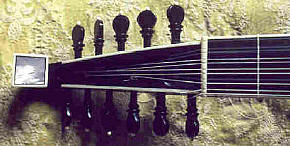 |
the peghead of the gallichone
(from website Busatolutes) |
For some more information
see Lutesandguitars.
|
| top |
|
 |
colascione
example : seen in Instrument Museum, Brussels |
L= B= H= mm
scale about 900 mm |
|
|
|
colascione
Around 1600 an instrument with the name colascione
(or sometimes calascione) was in use, mainly in Italy.
The colascione had a small, lute-like body and a very long
neck. It had 3 or 4 (bass) strings and a scale of 850-900mm (see modern
copies at Kirchmeyr).
This instrument was apparently mainly used in the Commedia
dell 'Arte.
For some more information about colascione
see Lutesandguitars.
|
| top |
|
 |
swedish lute
example :
bought via eBay, 2013 |
L=1060 B=365 H=130mm
scale 560 / 750mm |
|
|
Swedish
lute The Swedish lute (locally
known as Svenska lutan) is in fact a mixture of a cittern
and a lute, with some influence from the English guitar.
It was developed mainly by Mathias Kraft from Stockholm, in the second
half of the 18th century. Production stopped around 1820, but there
is a recent revival of the instrument.
The Swedish lute is a kind of theorbed cittern,
but with lute-like features : like gut strings, and the strings fixed
to a bridge glued to the front (and not running to pins at the end of
the body). The back of the body was usually slightly curved. It has
metal frets. The strings however were single (not double like on a
lute). Eight of the strings ran over the fingerboard, and 7 came
from the bass attachment.
 |
Most instruments had a
special device (a brass thumb-lever) to raise the pitch of all the
bass-strings one semitone.
picture :
from website Tabulatura |
The tuning of the 15 strings was : A B c# d e f# g /
a b c#' d' e' a' c#" e".
So only the first 4 strings were really played (in chords), all the
others followed the diatonic scale.
The modern version looks more like a harp-guitar, with 6 strings on
the fingerboard, and 6 bass-strings on the side of it. It may uses steel
strings in guitar-tuning, or nylon strings in renaissance-lute-tuning.
It does not have the pitch raising device.
For much more information about this instrument, see
Tabulatura
and Harpguitars.
|
| top |
|
 |
guitar lute
example :
bought from Germany
via eBay, 2004 |
L=950 B=330 H=140mm
scale 610mm |
|
|
|
guitar lute
In Germany in the 1920's people started singing old folk
songs and accompanied themselves on their guitar. But they
felt that a lute would be more appropriate for this "old"
music, so the guitar lute was introduced.
Made to look like the old renaissance lute (with 10-15 thin
separate ribs glued together for the body), but with a normal shape
guitar-neck and 6 proper (gut) guitar strings. The fretboard is flush
with the soundboard.
The bridge was often modelled on the baroque guitar (with some
kind of "mustache" on both sides) but the strings are fastened
with bridge pins. The soundhole has a rosette, carved in the wood (like
on the older lutes), or a separate piece of wood inserted in the soundhole.
The frets are normal metal guitar-style frets, with some made of wood
on the soundboard. Friction pegs are not used : just tuning machines
(2x 3). The peghead ends in a square scroll, like on the waldzittern,
but sometimes the top gets a more delicately carved head.
 |
Also harp guitar
lutes were made, with some 4 to 9 extra bass strings on a
separate theorbo-like "swan neck".
They are sometimes called : "Nordic Lute", but note
that this is not the Swedish lute (see above) !
See Harpguitars
for much more information.
The guitar lute was made in quite
large quantities in Germany and Austria, and there is still a
large trade in second hand instruments. They are nowadays often
strung with nylon strings and sound more or less like a normal
guitar.
left : swan neck guitar lute,
picture from eBay
|
|
| |
|
|
|



















